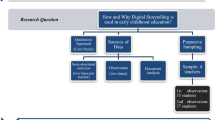Abstract
The benefits of drama have been reported extensively in educational research literature; however, few studies provide an in-depth analysis of how drama is used in early childhood classroom instruction for readers who struggle with comprehension. The focus of this study is: How do young children build literary understanding through drama? This seven-month qualitative study took place in a rural elementary school and shows how 10 first-graders who had been identified for the school's reading support program were capable of demonstrating rich understandings of children's literature on multiple levels through drama.

Similar content being viewed by others
References
Adomat, D. S. (2010). Dramatic interpretations: Performative responses of young children to picturebook read-alouds. Children's Literature in Education, 41, 207–221.
Allington, R. L. (2005). What really matters for struggling readers: Designing research-based programs (2nd ed.). Boston, MA: Allyn & Bacon.
Bernal, P. (2007). Acting out: Using drama with english learners. The English Journal, 96(3), 26–28.
Bidwell, S. M. (1990). Using drama to increase motivation, comprehension, and fluency. Journal of Reading, 34(1), 38–41.
Bolton, G. (2007). A history of drama education: The search for substance. In L. Bresler (Ed.), International handbook of research in arts education (Vol. 1, pp. 45–62). Dordrecht: Springer.
Booth, D. W. (2007). Story drama: Creating stories through role playing, Improvising, and reading aloud. Markham, Ontario: Pembroke Publishers.
Crumpler, T. P. (2007). Educational drama as response to literature: Possibilities for young learners. In J. J. Schneider, T. P. Crumpler, & T. Rogers (Eds.), Process drama and multiple literacies (pp. 1–14). Portsmouth, NH: Heinemann.
Edmiston, B. (1993). Going up the beanstalk: Discovering giant possibilities for responding to literature through drama. In K. E. Holland, R. A. Hungerford, & S. B. Ernst (Eds.), Journeying: Children responding to literature (pp. 250–266). Portsmouth, NH: Heinemann.
Galda, L., & Liang, A. (2003). Literature as experience or looking for facts: Stance in the classroom. Reading Research Quarterly, 38(2), 268–275.
Hancock, M. R. (2007). A celebration of literature and response (3rd ed.). Upper Saddle River, NJ: Merrill.
Maxwell, J. A. (2004). Qualitative research design: An interactive approach. Thousand Oaks, CA: Sage Publications.
McMaster, J. C. (1998). “Doing” literature: Using drama to build literacy. The Reading Teacher, 51(7), 574–584.
Miccinati, J. L., Sanford, J. B., & Hepner, G. (1983). Teaching reading through the arts. The Reading Teacher, 36, 412–417.
Moeller, K. J. (2004). Creating zones of possibility for struggling readers: A study of one fourth grader’s shifting roles in literature discussions. Journal of Literacy Research (36)4, 419–460.
Moran, K. J., & Meyer, M. J. (2009). Lighting the fires within: Pre-service teacher learning in and through drama. In M. Narey (Ed.), Making meaning: Constructing multimodal perspectives of language, literacy, and learning through arts-based early childhood education (pp. 207–228). New York: Springer.
O’Neill, C. (1995). Drama worlds: Framework for process drama. Portsmouth, NH: Heinemann.
Sipe, L. R. (2008). Storytime: Young children’s literary understanding in the classroom. New York: Teachers College Press.
Strauss, A., & Corbin, J. (2007). Basics of qualitative research (3rd ed.). Thousand Oaks, CA: Sage.
Tarlington, C., & Verriour, P. (1991). Role drama. Portsmouth, NH: Heinemann.
Wagner, B. J. (2003). Imaginative expression. In J. Flood, P. Lapp, J. R. Squire, & J. M. Jensen (Eds.), Handbook of research on teaching the English language arts (2nd ed., pp. 1008–1025). Mahwah, NJ: Lawrence Erlbaum Associates.
Wilhelm, J. D. (2002). Action strategies for deepening comprehension. New York: Scholastic.
Wilhelm, J. D. (2007). You gotta BE the book: Teaching engaged and reflective reading with adolescents (2nd ed.). New York: Teachers College Press.
Wiseman, A. (2011). Interactive read alouds: Teachers and students constructing knowledge and literacy together. Early Childhood Education Journal, 38, 431–438.
Wolf, S. A. (2004). Interpreting literature with children. Mahwah, NJ: Lawrence Erlbaum.
Children’s Literature Cited
Cowley, J. (1998). Oh, jump in a sack. Bothell, WA: The Wright Group.
Freeman, D. (1968). Corduroy. New York: Viking.
Henkes, K. (1993). Owen. New York: Greenwillow Books.
Hillman, J. (2000). Goldilocks and the three bears. Barrington, IL: Rigby.
Stevens, J. (1995). Tops and bottoms. Orlando, FL: Harcourt, Brace.
Author information
Authors and Affiliations
Corresponding author
Rights and permissions
About this article
Cite this article
Adomat, D.S. Drama’s Potential for Deepening Young Children’s Understandings of Stories. Early Childhood Educ J 40, 343–350 (2012). https://doi.org/10.1007/s10643-012-0519-8
Published:
Issue Date:
DOI: https://doi.org/10.1007/s10643-012-0519-8




